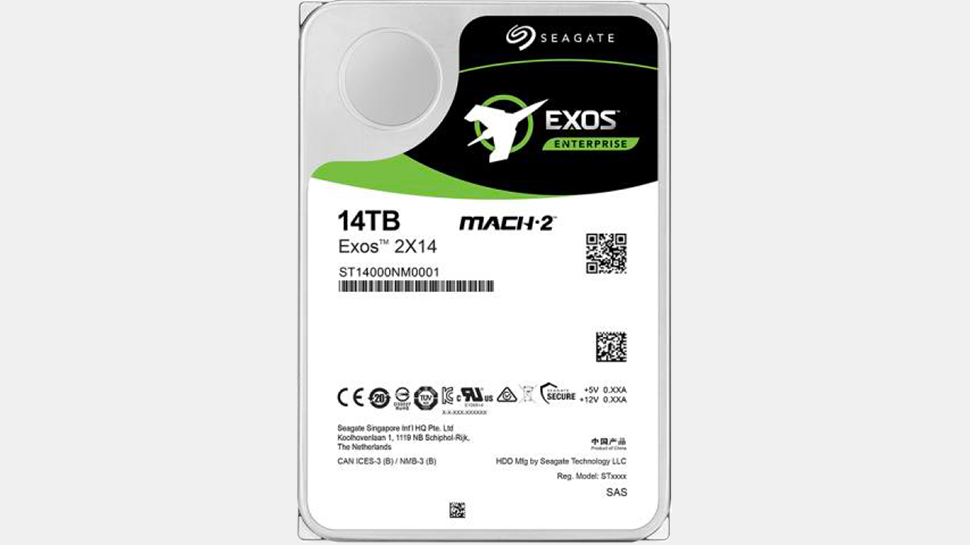Seagate has finally listed its dual-actuator hard disk drive — the Mach.2 Exos 2X14 — on its website and disclosed the official specs. With a 524MB/s sustained transfer rate, the Mach.2 is the fastest HDD ever, its sequential read and write performance is twice that of a normal drive. In fact, it can even challenge some inexpensive SATA SSDs.
The HDD is still available to select customers and will not be available on the open market, at least for the time being. Meanwhile, Seagate’s spec disclosure shows us what type of performance to expect from multi-actuator high-end hard drives.
Seagate Describes First Mach.2 HDD: the Exos 2X14
Seagate’s Exos 2X14 14TB hard drive is essentially two 7TB HDDs in one standard hermetically sealed helium-filled 3.5-inch chassis. The drive features a 7200 RPM spindle speed, is equipped with a 256MB multisegmented cache, and uses a single-port SAS 12Gb/s interface. The host system considers an Exos 2X14 as two logical drives that are independently addressable.
Seagate’s Exos 2X14 boasts a 524MB/s sustained transfer rate (outer diameter) of 304/384 random read/write IOPS, and a 4.16 ms average latency. The Exos 2X14 is even faster than Seagate’s 15K RPM Exos 15E900, so it is indeed the fastest HDD ever.
Furthermore, its sequential read/write speeds can challenge inexpensive SATA/SAS SSDs (at a far lower cost-per-TB). Obviously, any SSD will still be faster than any HDD in random read/write operations. However, hard drives and solid-state drives are used for different storage tiers in data centers, so the comparison is not exactly viable.
But performance increase comes at the cost of higher power consumption. An Exos 2X14 drive consumes 7.2W in idle mode and up to 13.5W under heavy load, which is higher than modern high-capacity helium-filled drives. Furthermore, that’s also higher than the 12W usually recommended for 3.5-inch HDDs.
Seagate says the power consumption is not an issue as some air-filled HDDs are power hungry too, so there are plenty of backplanes and servers that can deliver enough power and ensure proper cooling. Furthermore, the drive delivers quite a good balance of performance-per-Watt and IOPS-per-Watt. Also, data centers can use Seagate’s PowerBalance capability to reduce power consumption, but at the cost of 50% lower sequential read/write speeds and 5%~10% lower random reads/writes.
“3.5-inch air-filled HDDs have operated in a power envelope that is very similar to Exos 2X14 for many years now,” a spokesman for Seagate explained. “It is also worth noting that Exos 2X14 does support PowerBalance which is a setting that allows the customer to reduce power below 12W, [but] this does come with a performance reduction of 50% for sequential reads and 5%-10% for random reads.”
Since the Exos 2X14 is aimed primarily at cloud data centers, all of its peculiarities are set to be mitigated in one way or another, so slightly higher power consumption is hardly a problem for the intended customers. Nonetheless, the drive will not be available on the open market, at least for now.
Seagate has been publicly experimenting with dual-actuator HDDs (dubbed Mach.2) with Microsoft since late 2017, then it expanded availability to other partners, and earlier this year, it said that it would further increase shipments of such drives.
Broader availability of dual-actuator HDDs requires Seagate to better communicate its capabilities to customers, which is why it recently published the Exos 2X14’s specs.
“We began shipping [Mach.2 HDDs] in volume in 2019 and we are now expanding our customer base,” said Jeff Fochtman, Senior Vice President, Business and Marketing, Seagate Technology. “Well over a dozen major customers have active dual-actuator programs underway. As we increase capacities to meet customer needs, Mach.2 ensures the performance they require by essentially keeping the drive performance inside the storage to your expectations for hyperscale deployments.”
Keeping HDDs Competitive
Historically, HDD makers focused on capacity and performance: every new generation brought higher capacity and slightly increased performance. When the nearline HDD category emerged a little more than a decade ago, hard drive makers added power consumption to their focus as tens of thousands of HDDs per data center consumed loads of power, and it became an important factor for companies like AWS, Google, and Facebook.
As hard drive capacity grew further, it turned out that while normal performance increments brought by each new generation were still there, random read/write IOPS-per-TB performance dropped beyond comfortable levels for data centers and their quality-of-service (QoS) requirements. That’s when data centers started mitigating HDD random IOPS-per-TB performance with various caching mechanisms and even limiting HDD capacities.
In a bid to keep hard drives competitive, their manufacturers have to continuously increase capacity, increase or maintain sequential read/write performance, increase or maintain random read/write IOPS-pet-TB performance, and keep power consumption in check. A relatively straightforward way to improve the performance of an HDD is to use more than one actuator with read/write heads, as this can instantly double both sequential and random read/write speeds of a drive.
Not for Everyone. Yet
Seagate is the first to commercialize its dual-actuator HDD, but its rivals from Toshiba and Western Digital are also working on similar hard drives.
“Although Mach.2 is ramped and being used now, it’s also really still in a technology-staging mode,” said Fochtman. “When we reach capacity points above 30TB, it will become a standard feature in many large data center environments.”
For now, most of Seagate’s data center and server customers can get a high-capacity single-actuator HDD with the right balance between capacity and IOPS-per-TB performance, so the manufacturer doesn’t need to sell its Exos 2X14 through the channel. Meanwhile, when capacities of Seagate’s HAMR-based HDDs increase to over 50TB sometime in 2026, there will be customers that will need dual-actuator drives.
